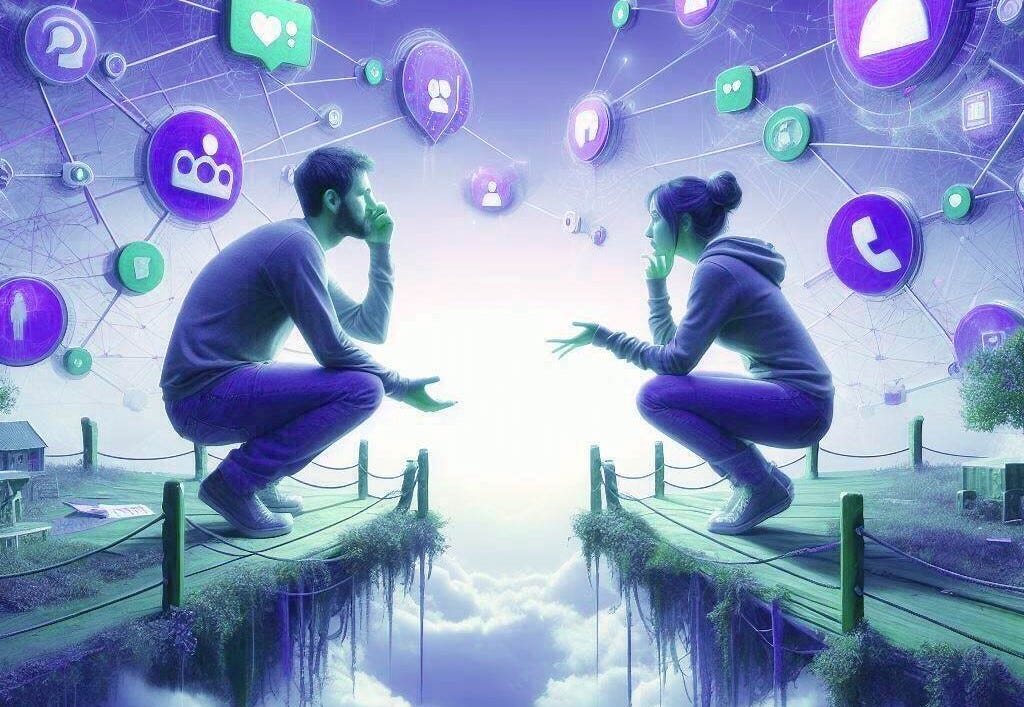[TRANSCRIPT]
We all speak in codes that can only be fully understood by people within our groups. Whether it’s industry jargon or inside jokes with our friends, we all sometimes say things that make no sense to or are misunderstood by those outside our group.
Hi everyone. Welcome to Digital Hope Talk. I’m Lauren Hug and I thank you for listening and being willing to explore better ways of navigating our digital world together.
This is Episode 10 — Are We Being Understood? Are We Understanding?: The importance of clarifying when communicating in digital spaces
My kids and I play a game called Dixit.
The cards are vibrant, detailed, whimsical works of art. One player is the “storyteller” tasked with choosing a card from their hand and saying something (anything that comes to their mind) about it. The rest of the players choose a card they think fits what the storyteller has said. The cards are then shuffled and laid out for players to guess which one was the storyteller’s. The storyteller only gets points, however, if at least one, but not all, of the players guess which card was theirs.
We’ve discovered it’s a challenge to tell stories broad enough to encompass more than one card, but specific enough that at least one player correctly chooses the storyteller’s card. If we speak in terms all players understand, then everyone chooses the storyteller’s card. But if we speak in terms only one other player understands, we’re almost guaranteed to win points as a storyteller. One player will immediately know which card is ours, while the rest are left to guess because they aren’t privy to the inside joke, code, or reference.
My kids are far better at playing that way than I am. They have a shared reservoir of memes, online games, and YouTube personalities they both know—and they know I don’t know. I understand glimmers of what they’re saying to each other, but don’t understand their nuance.
That’s how I feel reading some social media posts and threads. I know the words or images, but they’re being used in ways I don’t understand. There’s a conversation happening, but I’m not sure what it’s about or how to participate — or if it’s a conversation meant for me.
With the explosion of communication channels over the last two decades, stories are not as commonly held as they were in the days of only a handful of “mainstream” narrative outlets. As An Xioa Mina says in Memes to Movements: How the World’s Most Viral Media is Changing Social Protest and Power, there is no longer “a singular national narrative, or at least a singular set of facts… In a world of social media and multiple platforms, neither of these things is possible.”
I believe this is far more positive than negative because countless voices that were silenced or never deemed worthy by channel gatekeepers now have myriad avenues of communicating and being heard. But there’s no denying that the multitude of channels has fractured a shared understanding of the world … as well as the words, images, and cultural shorthand we use to communicate about it.
When we reach beyond our preferred circles and viewpoints, we often find it hard to communicate with people from “other” sides. We assume it’s because we don’t see eye to eye—and sometimes that’s true—but the first question to ask is: are we even speaking the same language? Are we using the same words, but interpreting them differently? Are we talking in ways that seem natural and obvious to us, but have little to no meaning to those outside our circle? Are they doing the same?
The term “dog whistle” has been used a lot lately to reference coded words or phrases that appear to have one meaning generally, but are understood differently by a specific group. The truth is, we all speak in codes that can only be fully understood by people within our groups. Whether it’s industry jargon, religious concepts, cultural expressions, or inside jokes with our friends, we all sometimes say things that make no sense to or are misunderstood by those outside our group.
We don’t tend to notice we’re speaking in code because we automatically adapt our communication when an in-person conversation partner gives us a cue we’ve said something our they didn’t understand or disagreed with. One of my first days in London while studying for my Master of Laws, a fast food cashier briskly asked me “Here or take-away?” as I approached the counter. I stared blankly at her. First, she repeated the question, assuming I hadn’t heard the words. Then, she asked me if I spoke English. I laughed, bewildered, and said I did, but that I hadn’t understood the question. She then said – verrrrrrrry slowly – “Are you going to eat here or take away?” Finally, I understood. Though I had heard her initial words and knew the meaning of them generally, I was used to hearing “here or to go?” (Not “take away.”) It took my brain a bit more context to decode the unexpected phrasing, even though the meaning of the words is otherwise obvious.
In-person conversations offer us a lot of clues as to whether we’re being understood. A confused or blank expression prompts us to rephrase, define, or clarify. Often, a conversation partner will interrupt us to ask for clarification or offer a different interpretation of the term or phrase we used.
But even with ample clues from facial expressions, tone of voice, body language, and direct questions or interruptions, in-person conversations are fraught with misunderstandings.
We make assumptions about what the other person means, and we don’t always make the right ones. We focus on making our next point rather than seeking to understand what our conversation partner is really saying.
“Most of us do not feel heard much of the time,” says Amanda Ripley in High Conflict: Why We Get Trapped and How We Get Out. She continues: “That’s because most people don’t know how to listen.” Bad listening has serious consequences. Ripley again: “When people don’t feel heard, they get slightly anxious and defensive. They say less, and whatever they do say tends to be oversimplified. The walls go up.”
She suggests using “looping” – a practice of repeating what we think we heard our conversation partner say, then asking them if we’ve heard correctly. It demonstrates a commitment to understanding our conversation partner, and it gives them the opportunity to clarify what they said, zeroing in on what they’re truly trying to communicate. I include looping exercises in my workplace communication workshops, and people tend to report that it makes them feel heard and more connected with their conversation partner.
That’s important! As Ripley says: “When people do feel heard, magical things happen. They make more coherent and intriguing points. They acknowledge their own inconsistencies. Willingly. They become more flexible.”
Doesn’t that sound like exactly what we need more of in digital spaces?
While online conversations lack non-verbal cues or immediate questions and interruptions to help participants better understand each other, looping is a technique that can enhance digital discourse. We can tell people how we’re interpreting what they’re saying and then ask if we’re understanding correctly. Not as debaters seeking to win points, but as human beings engaging with curiosity in search of inclusive and meaningful discourse.
As tempting as it is to assume we know what someone means by a social media post, we won’t really know until we ask them. Our questions might help them realize what they posted doesn’t accurately reflect what they intended to communicate.
The same goes for our own communications. We should consider whether we’re unintentionally speaking in code, and be willing to patiently clarify, define, and over-explain what we mean and where we're coming from.
As Melody Stanford Martin says in Brave Talk: Building Resilient Relationships in the Face of Conflict.
“In big and small ways, we all communicate differently. Truly understanding another person, especially in difficult conversations, requires taking the time to orient to their communication style. As we interpret their words and intentions to the best of our ability, we should be aware of how we are communicating. In any given situation, we might also ask ourselves if there are any ways we can adjust for maximum understanding and connection.”
To have productive online conversations with people from different perspectives, we need to communicate in ways a broad cross-section can understand. We have to abandon assumptions about what the “other” side means, ask if we understood correctly, and have the patience to both seek and provide more clarification than may be necessary when communicating in person.
Easier said than done, I know. But who’s game to try with me?
And what else do you think needs to be considered when seeking understanding in digital spaces?











